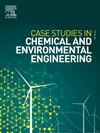Cigarette butt filter as membrane material with tannic acid and FeCl3 additives for improve antifouling properties
Q1 Environmental Science
Case Studies in Chemical and Environmental Engineering
Pub Date : 2025-01-11
DOI:10.1016/j.cscee.2025.101105
引用次数: 0
Abstract
Membrane fouling remains a critical challenge in wastewater treatment, particularly in applications involving oil-water emulsions. This study addresses this issue by fabricating antifouling membranes from repurposed cigarette filter waste, modified with tannic acid and FeCl3 (ferric chloride) coatings. These modifications enhance membrane hydrophilicity, antifouling properties, flux recovery, and selectivity through an environmentally friendly approach. The membranes were prepared using the non-solvent induced phase separation (NIPS) method and subsequently coated through vacuum filtration. Key performance metrics included pure water flux, oil emulsion selectivity, and antifouling properties. The antifouling mechanism was attributed to the hydrophilic and protective layers formed by the tannic acid and FeCl3 modifications, which reduced fouling and improved flux recovery. Characterization revealed that the tannic acid and FeCl3 modifications created a hydrophilic layer with uniform pore distribution, leading to an oil rejection rate of up to 97 % and an increased flux recovery ratio of 85 %, compared to 65 % in unmodified membranes. The results highlight the potential of waste-derived membranes as a sustainable alternative for industrial wastewater treatment, aligning with the principles of circular economy and green chemistry. Future work should explore long-term stability, surface charge effects, and optimization of additive concentrations to enhance performance and antifouling efficiency further.
烟头过滤嘴作为膜材料,加入单宁酸和FeCl3添加剂,提高防污性能
膜污染仍然是废水处理中的一个关键挑战,特别是在涉及油水乳液的应用中。本研究通过用单宁酸和FeCl3(氯化铁)涂层改性的香烟过滤嘴废料制造防污膜来解决这一问题。这些修饰通过环境友好的方式增强了膜的亲水性、防污性能、通量回收率和选择性。采用非溶剂诱导相分离(NIPS)法制备膜,并通过真空过滤进行包覆。关键性能指标包括纯水通量、油乳化选择性和防污性能。其防污机理归因于单宁酸和FeCl3改性形成的亲水性和保护层,减少了污染,提高了通量回收率。表征表明,单宁酸和FeCl3改性形成了具有均匀孔隙分布的亲水性层,与未改性膜的65%相比,其排油率高达97%,通量回收率提高了85%。研究结果强调了废物衍生膜作为工业废水处理的可持续替代方案的潜力,符合循环经济和绿色化学的原则。未来的工作应该探索长期稳定性、表面电荷效应和添加剂浓度的优化,以进一步提高性能和防污效率。
本文章由计算机程序翻译,如有差异,请以英文原文为准。
求助全文
约1分钟内获得全文
求助全文
来源期刊

Case Studies in Chemical and Environmental Engineering
Engineering-Engineering (miscellaneous)
CiteScore
9.20
自引率
0.00%
发文量
103
审稿时长
40 days
 求助内容:
求助内容: 应助结果提醒方式:
应助结果提醒方式:


